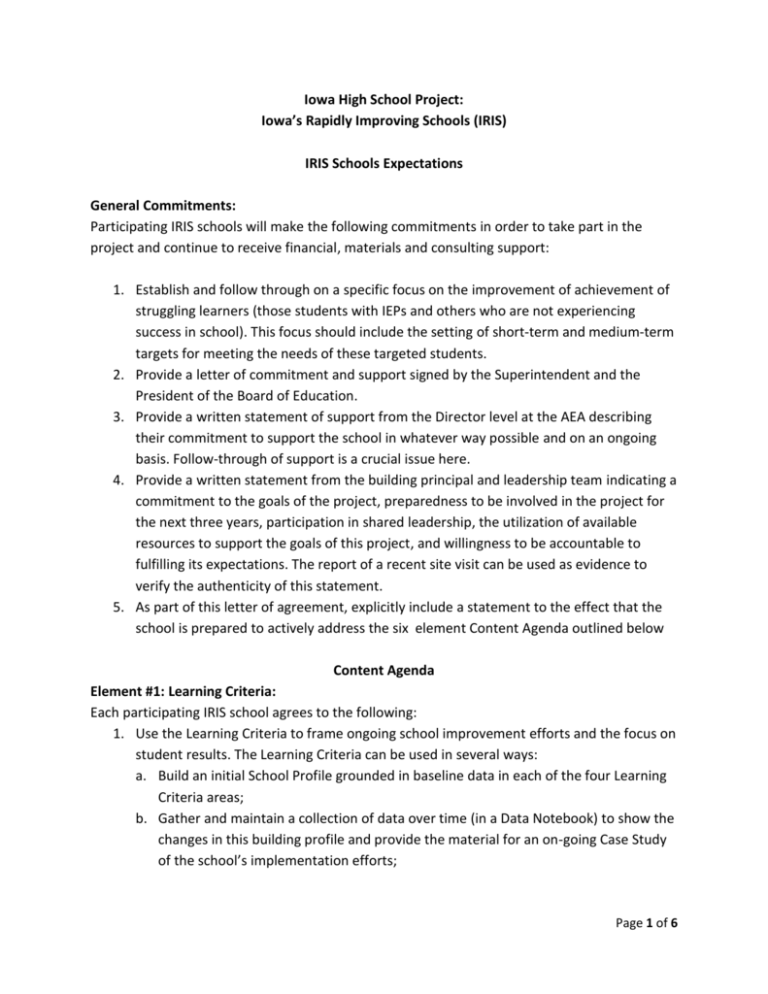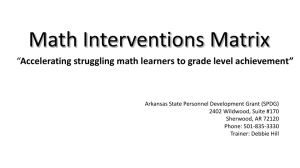IRIS Expectations
advertisement

Iowa High School Project: Iowa’s Rapidly Improving Schools (IRIS) IRIS Schools Expectations General Commitments: Participating IRIS schools will make the following commitments in order to take part in the project and continue to receive financial, materials and consulting support: 1. Establish and follow through on a specific focus on the improvement of achievement of struggling learners (those students with IEPs and others who are not experiencing success in school). This focus should include the setting of short-term and medium-term targets for meeting the needs of these targeted students. 2. Provide a letter of commitment and support signed by the Superintendent and the President of the Board of Education. 3. Provide a written statement of support from the Director level at the AEA describing their commitment to support the school in whatever way possible and on an ongoing basis. Follow-through of support is a crucial issue here. 4. Provide a written statement from the building principal and leadership team indicating a commitment to the goals of the project, preparedness to be involved in the project for the next three years, participation in shared leadership, the utilization of available resources to support the goals of this project, and willingness to be accountable to fulfilling its expectations. The report of a recent site visit can be used as evidence to verify the authenticity of this statement. 5. As part of this letter of agreement, explicitly include a statement to the effect that the school is prepared to actively address the six element Content Agenda outlined below Content Agenda Element #1: Learning Criteria: Each participating IRIS school agrees to the following: 1. Use the Learning Criteria to frame ongoing school improvement efforts and the focus on student results. The Learning Criteria can be used in several ways: a. Build an initial School Profile grounded in baseline data in each of the four Learning Criteria areas; b. Gather and maintain a collection of data over time (in a Data Notebook) to show the changes in this building profile and provide the material for an on-going Case Study of the school’s implementation efforts; Page 1 of 6 2. 3. 4. 5. c. Gather and maintain a collection of data over time at the individual student level, again using the Learning Criteria as a frame of reference; d. In using the Learning Criteria with the targeted students, while each Learning Criteria area is important, it is vital to provide Stretch Learning opportunities for struggling learners. Report twice annually on implementation and student results in each area of the Learning Criteria. Use “We Suite” (made available through the Successful Practices Network) as a tool to monitor student and teacher perceptions regarding student engagement with learning and school, while monitoring in particular the growth of the targeted groups of students. Gather and use any and all other sources of data available in the context of each focus area of the Learning Criteria as a basis of goal setting, planning, implementing, monitoring, and reporting. When developing and using an individual student version of the profile based on Learning Criteria, make every effort to link this work with 8th Grade Plans, combining them, if possible, into an Individual Learning Plan format. Element #2: Professional Development: As part of each participating IRIS school’s professional development efforts a leadership team will attend five regional workshops during 2009-2010 and, as part of each session, be prepared and willing to share and showcase progress and results with other participating schools. Element #3: Struggling Learners: Each participating IRIS school will put a clear and specific focus on student success by doing the following: 1. Focus its improvement efforts (including the short- and medium-term targets) and professional development activities on raising the achievement levels of struggling learners (students with IEPs and others who are not experiencing success in school). 2. Ensure that all decisions regarding professional development are data-driven. 3. Monitor and report results over time in terms of success with both the targeted groups of students and the interventions mounted. 4. Provide data related to the indicators included in the State Performance Plan. Element #4: Iowa Core: Each participating IRIS school agrees to link the focus of the implementation plan required by the Iowa Core Curriculum and the performance goals and specific targets of this project by doing the following: Page 2 of 6 1. Implementing the Iowa Core so that each and every student has access to and is taught the essential concepts and skills in the five areas included in the Iowa Core, with particular reference being paid to the Skills for the Twenty-First Century which can be so supportive for struggling learners. 2. Provide each and every struggling learner (students with IEPs and others who are not experiencing success in school) the opportunity to learn the essential concepts and skills from the Iowa Core, which means providing access to the general education curriculum for all students. 3. Commit to monitoring the progress of each and every struggling learner in accomplishing the expectations of the school for each of Iowa Core Essential Concepts and Skills (the target group includes all those students involved with ITEDs and other statewide measures). 4. In doing the above, make every effort to change the role of the special education teacher so that an increased number of students (particularly the targeted groups) benefit from the support of collaborative co-teaching partnerships responsible for content delivery. Element #5: Characteristics of Effective Instruction Participating IRIS schools will frame their work with professional development focused on the improvement of instruction and identify the implications and impact on struggling learners in the following ways: 1. Use the framework of the Characteristics of Effective Instruction1 identified by the Iowa Core and structure professional development and follow up instruction focused on struggling learners (students with IEPs and others who are not experiencing success in school) including: a. Teaching for Understanding b. Assessment for Learning (which can be so effective when used with struggling learners and those with IEPs) c. Rigor and Relevance d. Teaching for Learner Differences e. Student Centered Classrooms 2. Integrate any new and existing professional development efforts with one another to improve instruction and help achieve the success of struggling learners. The emphasis in this project, however, is on interventions not just on coordinating and conducting professional development programs. The commitment is also on identifying and using the specific intervention for each and every targeted student that helps them succeed. 1 Each participating school will have access to introductory training from its AEA on each of the five Characteristics of Effective Instruction. Page 3 of 6 3. Provide collaborative instruction (co-teaching) that targets the success of struggling learners in a way that provides the most effective instruction and support that is possible based on the combined knowledge and skills of the teachers involved in the instructional partnership. 4. Place particular emphasis on instruction that engages each and every student including those identified as struggling learners in challenging learning experiences. Element #6: Using a Systems Approach Participating IRIS schools agree to the following commitments: 1. Establish a school culture and climate that supports the learning of each and every learner including struggling learners (students with IEPs and others who are not experiencing success in school). 2. Identify how all improvement efforts complement and support one another and arrange these efforts in such a way that staff members see and act on these connections. 3. Focus all intervention efforts on IRIS goals and targets within the framework of the Learning Criteria. Whether they are referred to as IDM, Pyramid of Interventions (DuFour), problem solving, Learning Supports or RTI, the school should be prepared to establish a system of interventions that can be used judiciously and strategically to enhance the learning of the individual and groups of struggling learners. 4. Form active partnerships and undertake community outreach to establish learning supports and provide service learning opportunities in support of struggling learners. 5. Participate in an annual site visit conducted by Iowa-based IRIS consultants and representatives of the Successful Practice Network during which both qualitative and quantitative data pertaining to the experience and success of struggling learners will be made available. 6. Participate as a case study school using action research methods to describe and showcase the work of the school in accomplishing the goals of this project. As mentioned previously, these case studies should start with the school’s Learning Criteria Profile and then show changes in the accumulating data over time. A Data Notebook should be the basis of this case study and should contain the following: a. The Learning Criteria Profile containing all relevant base-line data; b. Results over three years in each of the selected data point areas; c. We Suite data, again showing changes over time; d. Annual reports from site visits; e. The results of “study tour” team visits2. 2 “Study Tours” involve representatives from participating schools in visiting other participating schools to learn more in-depth what is effective and to have the opportunity for direct contact with leadership teams and staff on site. Page 4 of 6 7. Use of a variety of data gathering tools and makes regular use of the data to adjust planning and implementation, including drilling down to examine the progress of the targeted groups of students. 8. Communicate with the community using data pertinent to the success of struggling learners. 9. Link with the AEA and utilize available resources in a way that supports local district efforts to improve the success of struggling learners. 10. Use the Successful Practices Network on a regular basis including web page access, CORR, and Liaisons. 11. Establish a shared leadership approach and commit to ongoing leadership development. Assurances to IRIS Schools: 1. Participating IRIS schools will be provided with additional reimbursement of a minimum of $7,500 per school per annum to provide compensation for travel, substitutes and approved expenditures related to the school’s participation in the project. The overall money value of all supports provided, of course, is considerably more than this particular sum. 2. Time and access will be provided through the IRIS Connection to build connections with other participating schools for an exchange of progress, ideas, questions and concerns. 3. Continued membership in the Successful Practices Network will be provided and each participating school is encouraged to use it extensively and effectively. 4. Access to the same representative from the Successful Practices Network will be made available to all participating schools to help assure continuity of communications among participating schools. 5. Professional development in support of identified needs will be provided through the IRIS Connection. 6. Assistance with how to arrange current school improvement and professional development efforts so that they are focused on supporting the success of struggling learners. 7. Additional training materials as part of professional development will be provided as needed. 8. Recognition as a rapidly improving school will be provided, as will the opportunity to showcase the best practices and successful results to other interested schools across the state and nation. 9. Direct support and coaching for a particular school’s leadership team from the IRIS consultants will be provided on a regular basis. Page 5 of 6 10. Access to other schools as part of a “study tour” arrangement by means of which teams from IRIS schools will have the opportunity to visit each others’ schools and therefore learn from one another. Page 6 of 6









